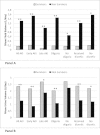Fluid balance and urine volume are independent predictors of mortality in acute kidney injury
- PMID: 23347825
- PMCID: PMC4057508
- DOI: 10.1186/cc12484
Fluid balance and urine volume are independent predictors of mortality in acute kidney injury
Abstract
Introduction: In ICUs, both fluid overload and oliguria are common complications associated with increased mortality among critically ill patients, particularly in acute kidney injury (AKI). Although fluid overload is an expected complication of oliguria, it remains unclear whether their effects on mortality are independent of each other. The aim of this study is to evaluate the impact of both fluid balance and urine volume on outcomes and determine whether they behave as independent predictors of mortality in adult ICU patients with AKI.
Methods: We performed a secondary analysis of data from a multicenter, prospective cohort study in 10 Italian ICUs. AKI was defined by renal sequential organ failure assessment (SOFA) score (creatinine >3.5 mg/dL or urine output (UO) <500 mL/d). Oliguria was defined as a UO <500 mL/d. Mean fluid balance (MFB) and mean urine volume (MUV) were calculated as the arithmetic mean of all daily values. Use of diuretics was noted daily. To assess the impact of MFB and MUV on mortality of AKI patients, multivariate analysis was performed by Cox regression.
Results: Of the 601 included patients, 132 had AKI during their ICU stay and the mortality in this group was 50%. Non-surviving AKI patients had higher MFB (1.31 ± 1.24 versus 0.17 ± 0.72 L/day; P <0.001) and lower MUV (1.28 ± 0.90 versus 2.35 ± 0.98 L/day; P <0.001) as compared to survivors. In the multivariate analysis, MFB (adjusted hazard ratio (HR) 1.67 per L/day, 95%CI 1.33 to 2.09; <0.001) and MUV (adjusted HR 0.47 per L/day, 95%CI 0.33 to 0.67; <0.001) remained independent risk factors for 28-day mortality after adjustment for age, gender, diabetes, hypertension, diuretic use, non-renal SOFA and sepsis. Diuretic use was associated with better survival in this population (adjusted HR 0.25, 95%CI 0.12 to 0.52; <0.001).
Conclusions: In this multicenter ICU study, a higher fluid balance and a lower urine volume were both important factors associated with 28-day mortality of AKI patients.
Figures




References
-
- Mehta RL, Bouchard J. Controversies in acute kidney injury: effects of fluid overload on outcome. Contrib Nephrol. 2011;17:200–211. - PubMed
Publication types
MeSH terms
LinkOut - more resources
Full Text Sources
Other Literature Sources
Medical

